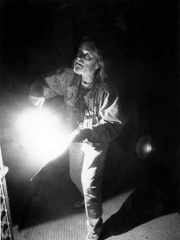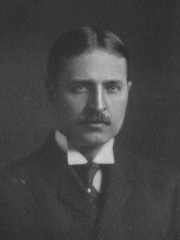FILM DIRECTOR
Stan Brakhage
1933 - 2003

 Stan Brakhage
Stan Brakhage
James Stanley Brakhage ( BRAK-ij; January 14, 1933 – March 9, 2003) was an American experimental filmmaker. He is considered to be one of the most important figures in 20th-century experimental film. Over the course of five decades, Brakhage created a large and diverse body of work, exploring a variety of formats, approaches and techniques that included handheld camerawork, painting directly onto celluloid, fast cutting, in-camera editing, scratching on film, collage film and the use of multiple exposures. Interested in mythology and inspired by music, poetry and visual phenomena, Brakhage sought to reveal the universal, in particular exploring themes of birth, mortality, sexuality, and innocence. Read more on Wikipedia
His biography is available in 21 different languages on Wikipedia (up from 20 in 2024). Stan Brakhage is the 1,277th most popular film director (down from 1,215th in 2024), the 9,095th most popular biography from United States (down from 8,001st in 2019) and the 337th most popular American Film Director.
Memorability Metrics
Page views of Stan Brakhage by language
Among FILM DIRECTORS
Among film directors, Stan Brakhage ranks 1,277 out of 2,041. Before him are Luis Alcoriza, Ali Hatami, James Algar, Peter R. Hunt, Jaume Balagueró, and Andrew Adamson. After him are Tommy Lee Wallace, José Luis Cuerda, Cai Chusheng, Gregory Ratoff, Feng Xiaogang, and Max Hardcore.
Most Popular Film Directors in Wikipedia
Go to all RankingsLuis Alcoriza
1918 - 1992
HPI: 53.98
Rank: 1,271
Ali Hatami
1944 - 1996
HPI: 53.97
Rank: 1,272
James Algar
1912 - 1998
HPI: 53.97
Rank: 1,273
Peter R. Hunt
1925 - 2002
HPI: 53.97
Rank: 1,274
Jaume Balagueró
1968 - Present
HPI: 53.97
Rank: 1,275
Andrew Adamson
1966 - Present
HPI: 53.96
Rank: 1,276
Stan Brakhage
1933 - 2003
HPI: 53.95
Rank: 1,277
Tommy Lee Wallace
1949 - Present
HPI: 53.95
Rank: 1,278
José Luis Cuerda
1947 - 2020
HPI: 53.94
Rank: 1,279
Cai Chusheng
1906 - 1968
HPI: 53.94
Rank: 1,280
Gregory Ratoff
1897 - 1960
HPI: 53.94
Rank: 1,281
Feng Xiaogang
1958 - Present
HPI: 53.94
Rank: 1,282
Max Hardcore
1956 - 2023
HPI: 53.92
Rank: 1,283
Contemporaries
Among people born in 1933, Stan Brakhage ranks 432. Before him are Françoise Héritier, Anita Gradin, Alexander Mitta, Chita Rivera, Habib Thiam, and Leonid Bartenyev. After him are Jiří Lanský, Miklós Ambrus, Frank Murkowski, Tim Conway, George J. Mitchell, and Masae Kasai. Among people deceased in 2003, Stan Brakhage ranks 294. Before him are Franklin Farrell, Yuri Shchekochikhin, Valentin Gavrilov, Elliott Smith, Conrad Hall, and Jesse Carver. After him are Daphne Oram, Koloman Sokol, Curt Hennig, Warren Zevon, Arne Månsson, and Willem Slijkhuis.
Others Born in 1933
Go to all RankingsFrançoise Héritier
ANTHROPOLOGIST
1933 - 2017
HPI: 54.15
Rank: 426
Anita Gradin
POLITICIAN
1933 - 2022
HPI: 54.12
Rank: 427
Alexander Mitta
FILM DIRECTOR
1933 - 2025
HPI: 54.09
Rank: 428
Chita Rivera
ACTOR
1933 - 2024
HPI: 54.03
Rank: 429
Habib Thiam
POLITICIAN
1933 - 2017
HPI: 54.02
Rank: 430
Leonid Bartenyev
ATHLETE
1933 - 2021
HPI: 54.00
Rank: 431
Stan Brakhage
FILM DIRECTOR
1933 - 2003
HPI: 53.95
Rank: 432
Jiří Lanský
ATHLETE
1933 - 2017
HPI: 53.90
Rank: 433
Miklós Ambrus
ATHLETE
1933 - 2019
HPI: 53.88
Rank: 434
Frank Murkowski
POLITICIAN
1933 - Present
HPI: 53.87
Rank: 435
Tim Conway
ACTOR
1933 - 2019
HPI: 53.69
Rank: 436
George J. Mitchell
POLITICIAN
1933 - Present
HPI: 53.68
Rank: 437
Masae Kasai
VOLLEYBALL PLAYER
1933 - 2013
HPI: 53.65
Rank: 438
Others Deceased in 2003
Go to all RankingsFranklin Farrell
POLITICIAN
1908 - 2003
HPI: 54.16
Rank: 288
Yuri Shchekochikhin
POLITICIAN
1950 - 2003
HPI: 54.14
Rank: 289
Valentin Gavrilov
ATHLETE
1946 - 2003
HPI: 54.12
Rank: 290
Elliott Smith
MUSICIAN
1969 - 2003
HPI: 54.10
Rank: 291
Conrad Hall
WRITER
1926 - 2003
HPI: 54.07
Rank: 292
Jesse Carver
SOCCER PLAYER
1911 - 2003
HPI: 54.00
Rank: 293
Stan Brakhage
FILM DIRECTOR
1933 - 2003
HPI: 53.95
Rank: 294
Daphne Oram
MUSICIAN
1925 - 2003
HPI: 53.95
Rank: 295
Koloman Sokol
PAINTER
1902 - 2003
HPI: 53.79
Rank: 296
Curt Hennig
WRESTLER
1958 - 2003
HPI: 53.77
Rank: 297
Warren Zevon
MUSICIAN
1947 - 2003
HPI: 53.73
Rank: 298
Arne Månsson
SOCCER PLAYER
1925 - 2003
HPI: 53.71
Rank: 299
Willem Slijkhuis
ATHLETE
1923 - 2003
HPI: 53.65
Rank: 300
In United States
Among people born in United States, Stan Brakhage ranks 9,097 out of 20,380. Before him are Michael Rosenbaum (1972), Elmo Zumwalt (1920), Charlie Byrd (1925), Samuel P. Bush (1863), Isabel Sanford (1917), and Vince Boryla (1927). After him are James Stockdale (1923), Jenna Ortega (2002), Tommy Lee Wallace (1949), Florence Ballard (1943), Bill Camp (1961), and Hilarie Burton (1982).
Others born in United States
Go to all RankingsMichael Rosenbaum
ACTOR
1972 - Present
HPI: 53.96
Rank: 9,091
Elmo Zumwalt
MILITARY PERSONNEL
1920 - 2000
HPI: 53.96
Rank: 9,092
Charlie Byrd
MUSICIAN
1925 - 1999
HPI: 53.96
Rank: 9,093
Samuel P. Bush
BUSINESSPERSON
1863 - 1948
HPI: 53.96
Rank: 9,094
Isabel Sanford
ACTOR
1917 - 2004
HPI: 53.96
Rank: 9,095
Vince Boryla
BASKETBALL PLAYER
1927 - 2016
HPI: 53.95
Rank: 9,096
Stan Brakhage
FILM DIRECTOR
1933 - 2003
HPI: 53.95
Rank: 9,097
James Stockdale
MILITARY PERSONNEL
1923 - 2005
HPI: 53.95
Rank: 9,098
Jenna Ortega
ACTOR
2002 - Present
HPI: 53.95
Rank: 9,099
Tommy Lee Wallace
FILM DIRECTOR
1949 - Present
HPI: 53.95
Rank: 9,100
Florence Ballard
SINGER
1943 - 1976
HPI: 53.95
Rank: 9,101
Bill Camp
ACTOR
1961 - Present
HPI: 53.95
Rank: 9,102
Hilarie Burton
ACTOR
1982 - Present
HPI: 53.94
Rank: 9,103
Among FILM DIRECTORS In United States
Among film directors born in United States, Stan Brakhage ranks 337. Before him are Jack Sholder (1945), James Gray (1969), Andrew Stanton (1965), William C. deMille (1878), David Twohy (1955), and James Algar (1912). After him are Tommy Lee Wallace (1949), Max Hardcore (1956), Peter Berg (1962), Alfred E. Green (1889), Leon Shamroy (1901), and Rob Bowman (1960).
Jack Sholder
1945 - Present
HPI: 54.14
Rank: 331
James Gray
1969 - Present
HPI: 54.12
Rank: 332
Andrew Stanton
1965 - Present
HPI: 54.12
Rank: 333
William C. deMille
1878 - 1955
HPI: 54.10
Rank: 334
David Twohy
1955 - Present
HPI: 54.04
Rank: 335
James Algar
1912 - 1998
HPI: 53.97
Rank: 336
Stan Brakhage
1933 - 2003
HPI: 53.95
Rank: 337
Tommy Lee Wallace
1949 - Present
HPI: 53.95
Rank: 338
Max Hardcore
1956 - 2023
HPI: 53.92
Rank: 339
Peter Berg
1962 - Present
HPI: 53.92
Rank: 340
Alfred E. Green
1889 - 1960
HPI: 53.92
Rank: 341
Leon Shamroy
1901 - 1974
HPI: 53.91
Rank: 342
Rob Bowman
1960 - Present
HPI: 53.73
Rank: 343
























































